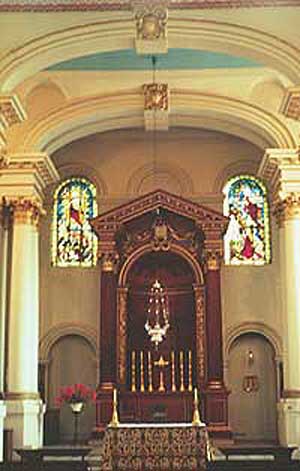
How Do Visual Arts Shape Spiritual Life?
Building Anglican Liturgy

Photo courtesy of the author
St. Mary Woolnoth
![]()
Building Anglican Liturgy
Response: Giving
Form to Anglican Liturgy in the City Churches of London
John W. Dixon, Jr.
At St. Mary Woolnoth, Hawksmoor was working with a much more restricted site that compelled him to use a more restrained plan. At St. Stephen, Wren had space enough for his subtle and eloquent combination of a basilican and centralized plan. Hawksmoor's design is purely central, a square with a central square raised on powerful columns. The only overt use of the horizontal movement is the placement of the altar on the wall opposite the entrance. The compactness of the design ensures fidelity to Wren's principle of enabling the congregation both to hear and to see the action of the service.
Since the spatial effect is close to being cubic, part of the affect is stillness. Within the stillness the great corner columns are an element of power but power under control. The effect is less subtle and graceful than Wren's but more forceful. The part of the building most admired by critics is the exterior, with its massive, heavy forms pressed into Baroque tension.
du Prey pays careful attention to Hawksmoor's many steeples and towers that complete other churches. Many parishes were nostalgic for their old Gothic steeples and Hawksmoor himself seemed to be fond of them. His designs are powerful, spikey, full of compressed energy, in an original and personal architectural vocabulary.
n the mid-19th century, the Oxford Movement (not to be confused with the later evangelical movement with the same name) and the Camden Society in Cambridge discussed at length the proper form of a church. This debate involved men of fine intelligence, deep piety, wide learning and the conclusion they came to - that the ideal Christian church should be the 14th century monastic church - is one of the worst ever proposed. Yet it has determined the form of hundreds of Anglican/Episcopalian churches.
I am anticipating a later article for this journal where my judgement might be debated, but I should say a bit about why I think this plan is so bad. First, it starts in the wrong place, with the kind of costume a church should wear, not what it should do. Inevitably, this means cluttering the church with a lot of bric-a-brac in good nineteenth century ("Victorian") taste. I confess to a weakness for this kind of thing but I feel guilty doing so; it certainly diffuses attention from the essentials.
Then, too, the stylistic choice was made to enhance the "mystery" of the Eucharist. It is always risky to design a building to produce a certain emotional affect, not to do its necessary work. This is playing a high class game with people's sensibilities. Most important, this desire for "mystery" meant putting the altar as far as possible from the congregation, making it the exclusive province of the priests. Moving the altar two feet from the wall does not solve this problem. The people become spectators rather than participants. This effect is enhanced by putting the choir in the monk's stalls, a major barrier between the people (the church!) and their altar. This made sense when the monks could face each other, chanting antiphonally. That is not the function of a choir, which should be an aid and supplement to the service, not a dominant event.
